What complex challenges can we help you navigate?
Email us:
health@thechangemakers.com

In the debut ChangeMakers Health report, we explore how health misinformation is showing up at the point of care and what healthcare professionals (HCPs) say must be addressed to support optimal patient care. Drawing on a national survey of General Practitioners and Family Physicians, Registered Nurses and Nurse Practitioners and Pharmacists; we examine the real-world consequences of false health narratives and the growing tension between patient autonomy and professional, clinical guidance.
The findings are clear: misinformation is no longer a fringe concern. It’s embedded in everyday care, and it’s changing the way patients seek, and sometimes avoid, treatment.
Key findings
This report offers a clear-eyed view of the challenges facing frontline care, and actionable insights for communicators, marketers, and healthcare leaders looking to make a meaningful difference.
Tom Yun, reporter with CanadianHealthcareNetwork.ca, attended our launch event and wrote: “Panellists agreed the internet has been a double-edged sword, given that clinicians now must field more questions pertaining to misinformation. “I’m seeing [misinformation] more and more. People seem to get their medical information from the internet, and they come to me to question what I’m doing,” Dr. Felix Klajner said. “At one point we used to worry about a lack of information and how patients don’t have access. But as Dr. Klajner just mentioned, the internet is just too much information,” said Tamar Elias, clinical pharmacist.”
To find out more, or engage our team, email us at:
health@thechangemakers.com



Email us:
health@thechangemakers.com

Working with the BC Ministry of Social Development and Poverty Reduction (SDPR), we were brought on to design and lead province-wide engagement to inform an update to TogetherBC: BC’s Poverty Reduction Strategy. As part of the strategy’s legislation, it must be updated every five years. We designed a robust engagement program seeking to gather input specifically from people with lived and living experience of poverty across BC. This included regional Town Halls, small group sessions, an online survey, DIY conversation toolkit, and other tactics including working with the Minister to host roundtable conversations. To ensure accessibility and inclusivity, we built in measures including honoraria, translation and interpretation, counselling, wellness supports, and coverage of other costs such as transportation, childcare and food when necessary. The project engaged approximately 10,000 people across British Columbia, including approximately 12% identifying as Indigenous. We crafted a What We Heard Report which will be presented to government to inform an update to the poverty reduction strategy in 2024.
Situation
Based on extensive initial engagement in 2017-18, TogetherBC, British Columbia’s Poverty Reduction Strategy, was released in 2019 and sets a path to reduce overall poverty in BC by 25% and child poverty by 50% by 2024. With investments from across Government, TogetherBC reflects government’s commitment to reduce poverty and make life more affordable for British Columbians. It includes policy initiatives and investments designed to lift people up, break the cycle of poverty and build a better BC for everyone.
Targets, timelines, and accountability for TogetherBC are laid out in the Poverty Reduction Strategy Act. This act states that the strategy is to be updated every five years. To inform the update to the strategy, the Government of BC engaged us to design, facilitate and report back on what poverty currently looks like across BC and potential solutions to addressing it from the perspective of those with lived and living experience and community members.
COVID-19, the housing crisis, climate emergencies and inflation are some major local and global events that have significantly impacted British Columbians. Government needed to understand the experiences on the ground and how these events have impacted certain populations and issues in different ways, as well as solutions that are making a difference, new programs and services needed, and where government can prioritize over the next five years of the strategy.
Problem
Since the current government in BC came into power, more than 378,000 people have been lifted out of poverty, including 104,000 children. However, much of this can be attributed to COVID-19 relief supports from the federal government, as well as other temporary measures during the pandemic. Other important actions have been completed that are making a difference in reducing poverty, but for some groups, it is still not enough and challenges remain.
Hearing directly from people with lived and living experience was also a direct mandate of this engagement, which presents major challenges requiring innovative thinking to ensure accessibility and very low barriers to participation.
Solution
We designed and facilitated a comprehensive engagement program resulting in a What We Heard report summarizing all the input from throughout the engagement period. Engagement tactics for this project included:
To ensure accessible engagement options, we coordinated significant supports including the following:
Promotion of the opportunity to engage was conducted through widespread community outreach, including through organizations on the ground, digital channels, and ministry offices. A QR code and link to the engagement website was included on two rounds of income assistance payments, as well as the myselfserve.gov.bc.ca website where individuals can access their government assistance information.
Results
The project remained on time and on budget, despite a large scope with a higher than average amount of expenses. The project engaged approximately 10,000 people across BC, including:
8,337 survey responses, which included:

The Locked Out campaign faced several challenges to raise awareness for IBD and public washroom accessibility. The activation — a real portable toilet placed in a public space — often led to preconceived assumptions, mirroring the stigma those with IBD face when seeking washrooms. This reinforced the need for targeted engagement to shift perceptions.
Stigma remains a barrier, as understanding of IBD, its symptoms and patient experiences are often overlooked. Positioning the stunt within Crohn’s and Colitis Awareness Month and sharing educational information was essential to breaking down misconceptions. The campaign relied on knowledgeable event staff to effectively communicate the message, which was supported by QR codes, signage, and live app demonstrations to ensure accessibility and education.
Engaging passers-by required adaptable strategies to capture attention and encourage participation. Crohn’s and Colitis Canada’s network of advocates played a key role in staffing the event, providing credible voices to reinforce the campaign’s message. Maximizing visibility required a strategic mix of organic and paid social content, ensuring reach beyond the physical activation. Targeted media outreach focused on Toronto to optimize resources and drive coverage, reinforcing the campaign’s urgency and impact.
To effectively engage key stakeholders and promote the GoHere® app during Crohn’s and Colitis Awareness Month, we analyzed and applied existing research on the needs and challenges of those who live with IBD. It was important to understand disease prevalence and patient experiences to ensure our program resonated with audiences. We examined insights into public washroom access barriers, stigma, and the need for real-time solutions, ensuring our messaging addressed the most pressing concerns. We also leveraged Vividata research to deepen our understanding of audience behaviors and media consumption patterns. These insights guided our strategic approach, enabling us to craft compelling content, target key demographics, and maximize engagement across multiple channels.
IBD diagnosis rates in Canada are increasing – and so are the needs for support. There is no cure for IBD. Approximately 322,000 Canadians live with IBD, with new diagnoses every 48 minutes. Patients experience lifestyle impacts, including chronic abdominal pain, frequent bathroom visits, and fatigue.1 Addressing IBD requires a thoughtful, sensitive, and real approach to the stigma that patients experience. Our strategy balanced empathy with practical solutions to drive engagement and app downloads.
Additional research findings: IBD often develops in young adults, typically between 16 and 35 years old, but can occur at any age. A second peak may occur in individuals over 60. Both men and women are equally affected.1 Patients experience significant lifestyle and psychosocial impacts such as mental health, diet and nutrition, and work and social life; Psychiatric disorders frequently occur among those with IBD: An estimated 21% have clinical anxiety; and an estimated 15% have clinical depression.2
News and social media consumption habits: Mobile (hours per week)3: Gen Z: 16.8; Millennial: 10.1; Gen X: 12.8; Social applications (hours per week)3: Gen Z: 15.8; Millennial: 15.1; Gen X: 8.2; TV (hours per week)3: Gen Z: 14.4; Millennial: 17.5; Gen X: 16.5; Online (hours per week)3: Gen Z: 28.7; Millennial: 25.6; Gen X: 24.7.
Those who care for individuals who live with IBD, usually family members, close friends or partners of those diagnosed. Research revealed that 56 per cent of caregivers feel exhausted from caregiving duties, and 44% report anxiety.4 Women are more likely to take on the caregiver role for children with IBD.5 IBD caregivers in Canada are essential to the well-being of individuals living with the condition. We needed to show support for the care they provide and make them aware of the GoHere® app to increase downloads and usage.
Policymakers: Those who shape public policy and address issues through legislation and decision-making. For non-profit organizations, this audience can influence resources, support advocacy efforts and shape the broader environment in which Crohn’s and Colitis Canada operates. Engagement with policymakers was essential to raise awareness and garner support for washroom accessibility initiatives in a sensitive way to make it easy for this audience to share our messages. We needed a demonstration of local political support to increase awareness and action.
News Media and Social Media: We targeted top-tier health reporters, online news outlets, and Crohn’s and Colitis Canada’s active social platforms (FB & IG) to reach key audiences. Insights showed that Gen Z, Millennials, and Gen X spend significant time on mobile and social media, making a shareable, timely event essential. Personal patient stories highlighted the GoHere® app’s impact, driving awareness and downloads. Securing a national health reporter with a personal connection to IBD further amplified engagement within the IBD community.
Environmental Scan: To understand the IBD landscape, we reviewed media coverage and patient testimonials. Results showed IBD awareness remains low, and the stigma surrounding the disease often prevents open conversations. Public washroom accessibility and reduced stigma emerged as a critical need for IBD patients.

To reduce stigma, we had to find a way to visualize the realities of washroom access needs for those who live with IBD. To achieve this, we produced a powerful visual centerpiece – an ‘out-of-order’ portable toilet – representing the challenges faced by individuals with Crohn’s or colitis in accessing public washrooms quickly. Through earned and social media, this activation sparked conversation and action on the GoHere® app during Crohn’s and Colitis Awareness Month.
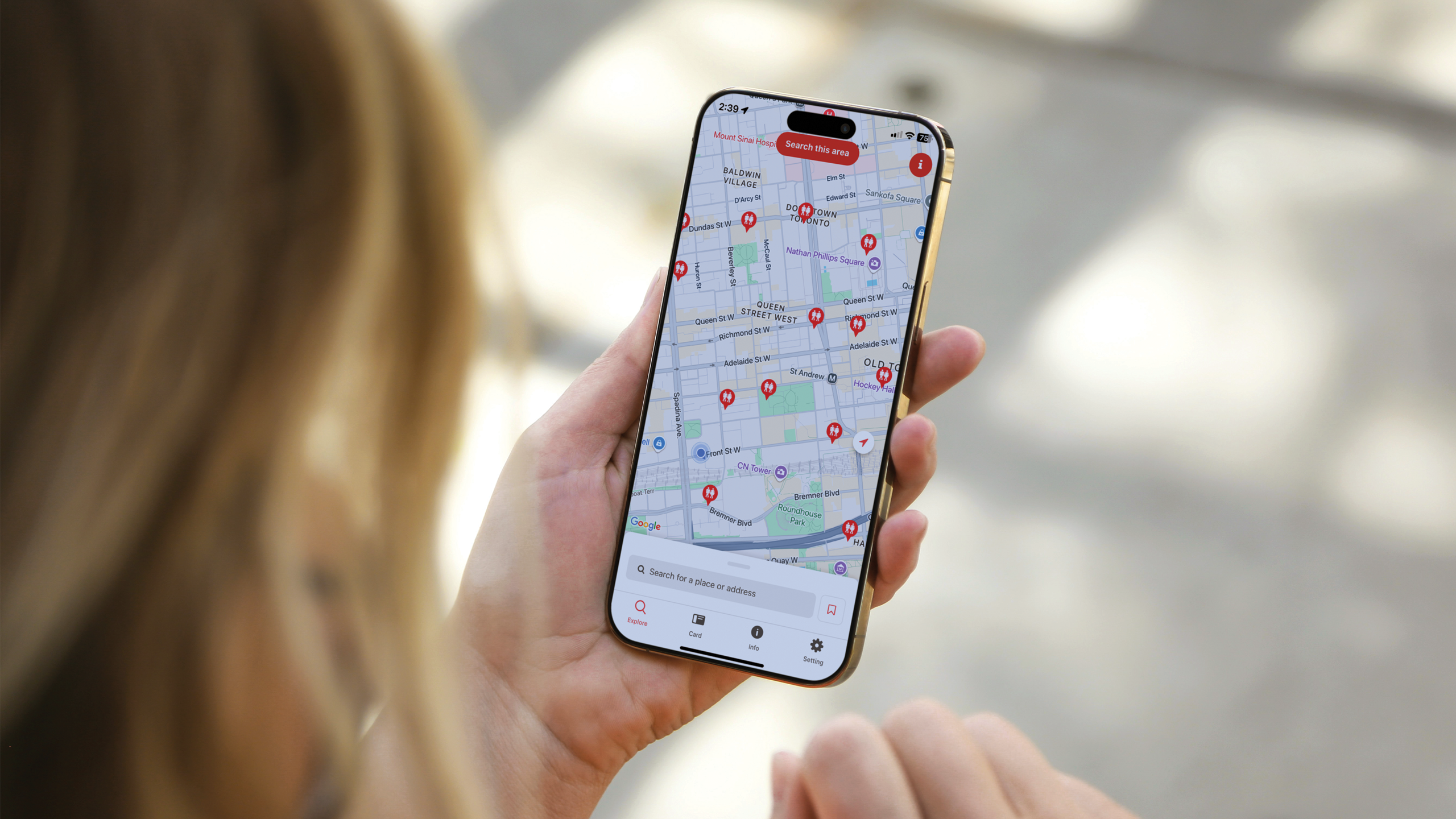
The campaign featured a high-impact public activation and a multi-channel communication strategy:
Call-to-Action: Event materials, earned and social media materials, and conversations encouraged attendees to scan the QR code and download the GoHere® app.
Event Execution: On November 26, 2024, we installed an ‘out-of-order’ portable toilet near Toronto’s Union Station to highlight the urgent need for accessible washrooms. Crohn’s and Colitis Canada staff and volunteers engaged the public with creative materials and a QR code for easy GoHere® app downloads.
Media Engagement: To broaden education beyond the event, we needed national media coverage for our story. This involved securing a nationally syndicated feature story, booking interviews for patient advocates and Crohn’s and Colitis Canada spokespeople, and sharing event photos with media outlets to provide audiences with the powerful visual to include in their stories.
Social Media Strategy: Organic and paid social media posts leveraged hashtags and influencer partnerships, and visual content from the event captured attention and drove app downloads.
Policymaker engagement: To amplify event support and impact, we engaged local MPs and MPPs to demonstrate their support. Mary-Margaret McMahon, MPP for Beaches-East York and Toronto City Councillor, Paul Ainslie, Scarborough-Guildwood, attended the event, shared on their social channels and encouraged GoHere® app downloads. This demonstration of local political support allowed for increased awareness and actionable items for local communities to consider.
Call-to-Action: Event materials, earned and social media materials, and conversations encouraged attendees to scan the QR code and download the GoHere® app.


At ChangeMakers, we specialize in helping agrifood and agribusiness companies succeed in the Canadian market. Whether you’re an international organization or a local producer, our team of agribusiness marketing experts and trade consultants provides the strategic guidance and in-market support you need to grow.
Our deep industry connections—with buyers, importers, distributors, retailers, foodservice operators, trade officials, and government agencies—give our clients a competitive edge.
From international trade marketing and trade missions to buyer outreach and trade show services; we offer end-to-end support for companies exporting food and drink to Canada.
We also support domestic Canadian organizations looking to expand through consumer promotions, retail activations, and trade marketing initiatives.”
Categories we support – and grow:
Aquaculture | Beverages – alcoholic & non-alcoholic | Commodity food products | Fresh produce | Consumer packaged goods (CPG) | Indigenous-owned agrifood products | Lumber & wood products | Meat & poultry | Private label products | Vegan & plant-based foods
Cross-border trade is complex—we make it easier. With ChangeMakers as your in-country consultant, you gain a trusted partner who understands the Canadian market and knows how to position you for success.




Working with the BC Ministry of Social Development and Poverty Reduction (SDPR), we were brought on to design and lead province-wide engagement to inform an update to TogetherBC: BC’s Poverty Reduction Strategy. As part of the strategy’s legislation, it must be updated every five years. We designed a robust engagement program seeking to gather input specifically from people with lived and living experience of poverty across BC. This included regional Town Halls, small group sessions, an online survey, DIY conversation toolkit, and other tactics including working with the Minister to host roundtable conversations. To ensure accessibility and inclusivity, we built in measures including honoraria, translation and interpretation, counselling, wellness supports, and coverage of other costs such as transportation, childcare and food when necessary. The project engaged approximately 10,000 people across British Columbia, including approximately 12% identifying as Indigenous. We crafted a What We Heard Report which will be presented to government to inform an update to the poverty reduction strategy in 2024.
Situation
Based on extensive initial engagement in 2017-18, TogetherBC, British Columbia’s Poverty Reduction Strategy, was released in 2019 and sets a path to reduce overall poverty in BC by 25% and child poverty by 50% by 2024. With investments from across Government, TogetherBC reflects government’s commitment to reduce poverty and make life more affordable for British Columbians. It includes policy initiatives and investments designed to lift people up, break the cycle of poverty and build a better BC for everyone.
Targets, timelines, and accountability for TogetherBC are laid out in the Poverty Reduction Strategy Act. This act states that the strategy is to be updated every five years. To inform the update to the strategy, the Government of BC engaged us to design, facilitate and report back on what poverty currently looks like across BC and potential solutions to addressing it from the perspective of those with lived and living experience and community members.
COVID-19, the housing crisis, climate emergencies and inflation are some major local and global events that have significantly impacted British Columbians. Government needed to understand the experiences on the ground and how these events have impacted certain populations and issues in different ways, as well as solutions that are making a difference, new programs and services needed, and where government can prioritize over the next five years of the strategy.
Problem
Since the current government in BC came into power, more than 378,000 people have been lifted out of poverty, including 104,000 children. However, much of this can be attributed to COVID-19 relief supports from the federal government, as well as other temporary measures during the pandemic. Other important actions have been completed that are making a difference in reducing poverty, but for some groups, it is still not enough and challenges remain.
Hearing directly from people with lived and living experience was also a direct mandate of this engagement, which presents major challenges requiring innovative thinking to ensure accessibility and very low barriers to participation.
Solution
We designed and facilitated a comprehensive engagement program resulting in a What We Heard report summarizing all the input from throughout the engagement period. Engagement tactics for this project included:
To ensure accessible engagement options, we coordinated significant supports including the following:
Promotion of the opportunity to engage was conducted through widespread community outreach, including through organizations on the ground, digital channels, and ministry offices. A QR code and link to the engagement website was included on two rounds of income assistance payments, as well as the myselfserve.gov.bc.ca website where individuals can access their government assistance information.
Results
The project remained on time and on budget, despite a large scope with a higher than average amount of expenses. The project engaged approximately 10,000 people across BC, including:
8,337 survey responses, which included:

Working with the BC Ministry of Social Development and Poverty Reduction (SDPR), we were brought on to design and lead province-wide engagement to inform an update to TogetherBC: BC’s Poverty Reduction Strategy. As part of the strategy’s legislation, it must be updated every five years. We designed a robust engagement program seeking to gather input specifically from people with lived and living experience of poverty across BC. This included regional Town Halls, small group sessions, an online survey, DIY conversation toolkit, and other tactics including working with the Minister to host roundtable conversations. To ensure accessibility and inclusivity, we built in measures including honoraria, translation and interpretation, counselling, wellness supports, and coverage of other costs such as transportation, childcare and food when necessary. The project engaged approximately 10,000 people across British Columbia, including approximately 12% identifying as Indigenous. We crafted a What We Heard Report which will be presented to government to inform an update to the poverty reduction strategy in 2024.
Situation
Based on extensive initial engagement in 2017-18, TogetherBC, British Columbia’s Poverty Reduction Strategy, was released in 2019 and sets a path to reduce overall poverty in BC by 25% and child poverty by 50% by 2024. With investments from across Government, TogetherBC reflects government’s commitment to reduce poverty and make life more affordable for British Columbians. It includes policy initiatives and investments designed to lift people up, break the cycle of poverty and build a better BC for everyone.
Targets, timelines, and accountability for TogetherBC are laid out in the Poverty Reduction Strategy Act. This act states that the strategy is to be updated every five years. To inform the update to the strategy, the Government of BC engaged us to design, facilitate and report back on what poverty currently looks like across BC and potential solutions to addressing it from the perspective of those with lived and living experience and community members.
COVID-19, the housing crisis, climate emergencies and inflation are some major local and global events that have significantly impacted British Columbians. Government needed to understand the experiences on the ground and how these events have impacted certain populations and issues in different ways, as well as solutions that are making a difference, new programs and services needed, and where government can prioritize over the next five years of the strategy.
Problem
Since the current government in BC came into power, more than 378,000 people have been lifted out of poverty, including 104,000 children. However, much of this can be attributed to COVID-19 relief supports from the federal government, as well as other temporary measures during the pandemic. Other important actions have been completed that are making a difference in reducing poverty, but for some groups, it is still not enough and challenges remain.
Hearing directly from people with lived and living experience was also a direct mandate of this engagement, which presents major challenges requiring innovative thinking to ensure accessibility and very low barriers to participation.
Solution
We designed and facilitated a comprehensive engagement program resulting in a What We Heard report summarizing all the input from throughout the engagement period. Engagement tactics for this project included:
To ensure accessible engagement options, we coordinated significant supports including the following:
Promotion of the opportunity to engage was conducted through widespread community outreach, including through organizations on the ground, digital channels, and ministry offices. A QR code and link to the engagement website was included on two rounds of income assistance payments, as well as the myselfserve.gov.bc.ca website where individuals can access their government assistance information.
Results
The project remained on time and on budget, despite a large scope with a higher than average amount of expenses. The project engaged approximately 10,000 people across BC, including:
8,337 survey responses, which included:
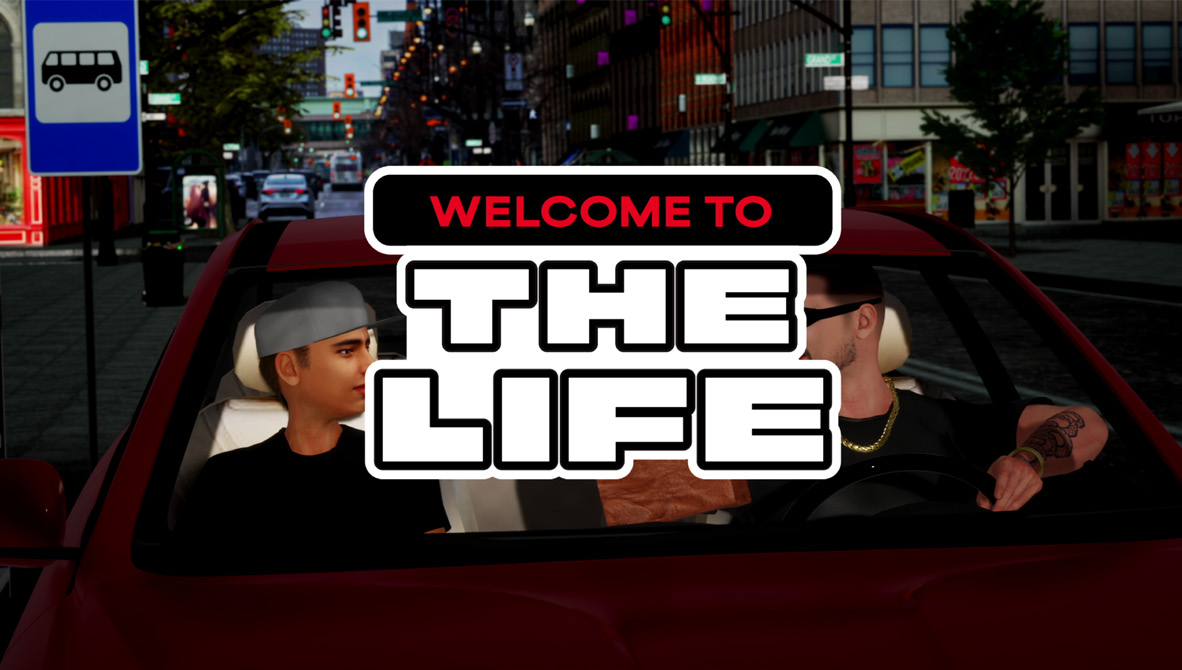
In 2019, Winnipeg Police Service’s Gangs and Guns unit estimated Winnipeg had 25-30 gangs and up to 4,000 gang members and associates. In 2022, it was estimated that there were 40 street gangs, many of them Indigenous-led. Youth at risk of recruitment have often experienced childhood trauma or live in poverty — the ripple effect of oppression across generations. High dropout rates and few economic opportunities for youth also contribute to gang recruitment success. Manitoba Association of Chiefs of Police (MACP) secured funding from Manitoba Justice to help youth avoid or leave gang involvement and partnered with Argyle to develop a powerful campaign to promote off-ramps to vulnerable youth.
This initiative featured three short, impactful videos, illustrating the vast difference between the myth of what gang life offers and the reality of what it delivers. The concept used a popular video game look and feel to reach viewers aged 13-16 in a way they could relate to as well as share. A phone number at the end of each video encouraged viewers to send a text message to The Link: Youth and Family Supports, a trusted community agency offering a potential lifeline for those wanting help to leave or resist gang life.
We reached youth with a digital campaign on social platforms including Facebook, Instagram, Snapchat and TikTok. Additionally, targeted YouTube ads ran on specific gang awareness channels in Manitoba. The initial digital campaign ran for six weeks from July 26 to September 12, 2023, with a second phase from November 9 to Dec 15, 2023.
To effectively reach Manitoba’s youth, Argyle worked closely with the Winnipeg Police Service’s anti-gang unit and reformed gang members to ensure our message, tone, visuals, and call to action resonated with young audiences.
Our research included the following:
As a result of our research, we learned:
Our goal
Through a public education and awareness campaign, we would offer vulnerable youth off-ramps to avoid or leave gang involvement and teach them about the harmful realities of gang life versus the myths used during recruitment.
Our strategy
To achieve this goal, we leveraged the lived experience of the reformed gang members we met to reach youth with authentic, real-life gang recruitment scenarios. As a first-year objective, we wanted to get young people’s attention, raise awareness and build trust. This is the starting point for a long-term approach to impacting gang recruitment. Helping influence youth to not move towards gang life was our goal, and one potential indicator would be the number of texts sent to The Link from youth looking for help. Our partnership with The Link was key as they have been serving youth in Winnipeg and northern Manitoba for close to 100 years. They are well known by youth, approachable and credible. Trust was the leading factor needed to encourage youth to click on the ad, visit the website, watch the videos and text for help.
| Objective | Metric |
|---|---|
| Awareness Get young people’s attention to the risks of gang life | 2 million advertising impressions 2 media coverage pieces about the launch |
| Trust Encourage youth to click on the ad, visit the website and watch the videos | 3,000 clicks to the link’s website |
| Action Help influence youth to avoid / move away from gang life | 30 youth using the text helpline |
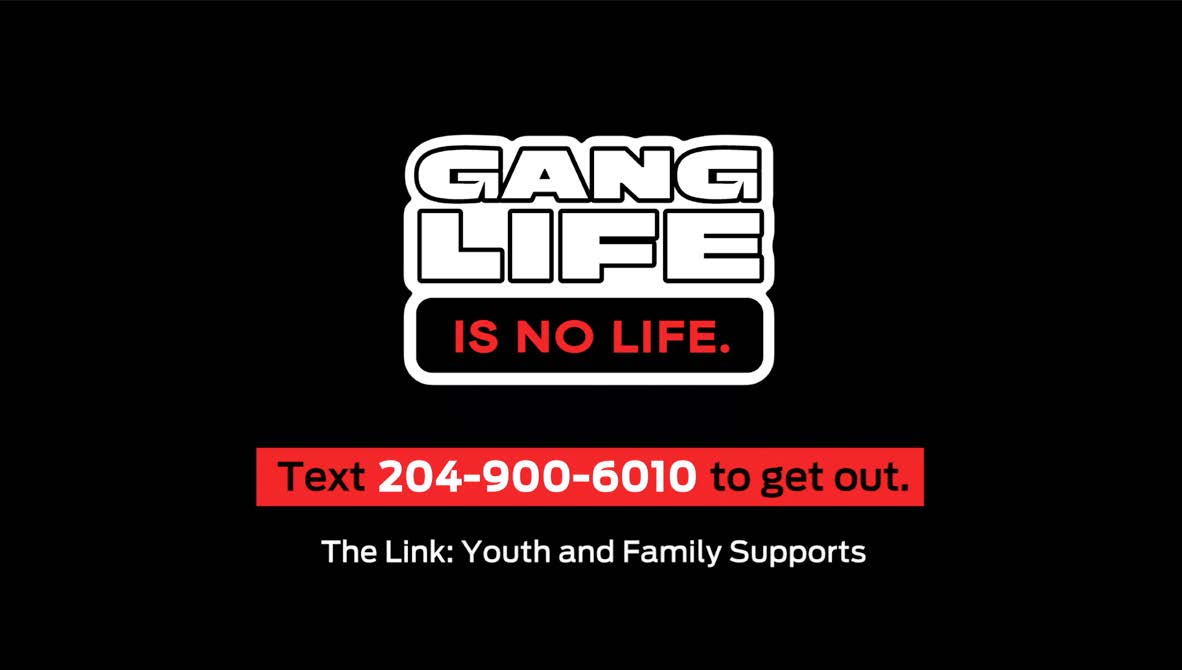
Using the insights we learned from our research, we developed three videos to address common scenarios within gang life including illegal drugs, sexual exploitation and gun violence based on real-life stories we heard about from our reformed gang member advisors. To make the videos attractive and relatable to youth, the style was based on popular video games, and we developed Gang Life is No Life characters, storylines and a call to action. In each of the three 15-second videos we were able to establish an action from a gang recruiter (The Ask; The Invite; and The Brotherhood) and then the resulting detrimental outcomes (The Give; The Cost; and The Bloodshed).
The background settings created for these three videos depict scenes common to many towns and cities within Manitoba. From a social housing project, to a mall, to a downtown scene that is recognizable as Winnipeg with its overhead walkways, the familiarity helped create a sense of authenticity and credibility – an important point we learned in our research and knew we had to achieve.
To make the action easy for youth, the end board offers the call to action to “text 204-910-6010 to get out”, and names The Link as the community agency offering help. Based on insights from our research, we deliberately did not include the MACP brand in the videos to ensure the message would be credible to youth.
The Gang Prevention Campaign was launched on July 26, 2023, with a news conference hosted at The Link. Emceed by steering committee chair Inspector Grant Stephen from the RCMP’s Federal Serious and Organized Crime Unit, the event featured a representative from Organized Crime with the Winnipeg Police Service (Inspector Elton Hall), a founder and action therapist from Spirit Horse Initiative whose team provides support to youth on the streets of downtown Winnipeg (Matt Davidson), and the CEO of The Link (Kerri Irvin-Ross). Media interest at the event was impressive with coverage from CTV, Global, CBC, Winnipeg Free Press, Winnipeg Sun and ChrisD.ca. There were also over a dozen organic social media posts thanks to partners including RCMP, Winnipeg Police Service, MACP, The Link and Spirit Horse Initiative.
We brought the videos to life with a digital campaign across social platforms popular with youth including Facebook, Instagram, Snapchat, and TikTok. Additionally, targeted YouTube ads ran on specific Manitoba gang awareness channels that we learned were frequented by youth interested in learning about gang activity across the province. The digital campaign launched for six weeks from July 26 – Sept 12 with a second six-week phase from Nov 9 – Dec 15.
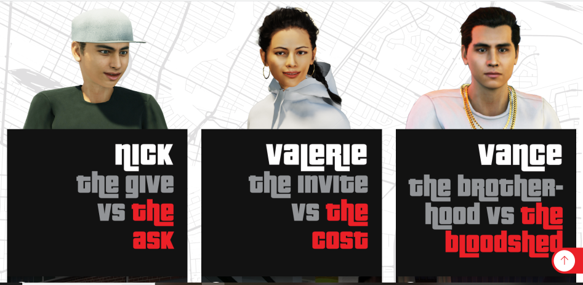
The campaign exceeded the client’s expectations, both on reach and engagement. On the ground, police enforcement tactics to reach youth attracted to gang recruitment had never before seen such success:
“Our gang prevention coordinator works with agencies in the community to provide an offramp for young people to exit gangs or the lifestyle. She has been very successful in referring youth to agencies over the previous three years. On average, she has provided assistance to between 20 and 30 youth annually. The Gang Life Is No Life campaign has provided an avenue for youth to connect directly to The Link and other social agencies at any time of the day, discreetly. This media campaign has resulted in over 150 referrals in a short period of time,”
Inspector Elton Hall, steering committee member from the Winnipeg Police Service.
Inspector Hall presented this campaign and its results to law enforcement audiences over the past few months. There is an appetite for replicating this approach in other jurisdictions both within Canada and into the US. MACP has secured funding from Manitoba Justice to continue the campaign in 2024. Creative ideation and planning are underway to build on our momentum.
11.68M
impressions
45,666
clicks to the Gang Life Is No Life webpage on The Link’s site
150
text conversations from 109 unique phone numbers
6
media outlets (print, TV, online)
SnapChat and TikTok were the most successful tactics of the campaign, demonstrating both strong click-through rates and low cost-per-click. This indicates a strong alignment between messaging and the target audience on these platforms.
We will anticipate, navigate and create change better than anyone else.
We exist to navigate complexity to help organizations make the most out of change. Our people embrace change, and strive to help clients, communities and individuals make the most of it through their expertise and craft.
We believe in people and their potential to listen, move, speak, create and grow. We support people so together we can do great things. We recognize our greatest potential is realized when we do it together, across all disciplines, for the greater benefit of our clients.
What do we offer beyond the ability to do incredible work with incredible people? How about industry-leading benefits, including professional development, and a promote-from-within philosophy that has enabled so many to build their careers at ChangeMakers! You will also have direct access to senior leaders who will help coach and mentor. You will be kept informed and engaged with very active internal communications and social teams.
If this sounds like a place you’d like to work, we’d love to hear from you.
Because you can never have too many great people on your team.
Contact us at Careers@TheChangeMakers.com

Pharma ads aren’t trying to be clever – just compliant
My son’s hockey team was down 1-0, and the third period was drawing to a close. I sat in the stands watching anxiously, trying to focus on the game. However, I couldn’t help eavesdropping on the parents next to me talking about pharmaceutical advertising. As someone who’s worked in pharma advertising for years, my ears perked up.
“What I don’t get is why they won’t tell us what the drug is for,” said the parent. “It’s all just, ‘See your doctor.’ I mean, What’s with the mystery?!”
“Well, I’m sure there’s a good reason,” said the other parent, oblivious to the score. “Maybe they are trying to be clever.”
I’m grateful there was a youth hockey game to distract me because every fibre of my being longed to leap out of my seat and shout at the top of my lungs: “We’re not being cute! We’re being compliant!”
To those who aren’t well-versed in the complexity of pharmaceutical advertising in Canada, pharma ads can seem purposefully vague and mysterious. No mention of what the drug actually does and what condition it treats. Just a cryptic “talk to your doctor” at the end. What many people don’t understand is that in Canada, direct-to-consumer, or DTC, marketing is subject to Section C.01.044 of the Food and Drugs Act, which states that if advertising a prescription drug to the general public, only the brand name, the price and quantity of the medication can be referenced.
It is quite literally against the law to mention the therapeutic use of a prescription drug in Canadian consumer advertising. Additionally, all pharmaceutical content undergoes rigorous internal reviews – by Medical, Regulatory and Legal Departments – and external evaluation by Ad Standards Canada.
This makes marketing pharma very different from marketing other products; imagine trying to create an ad for paper towel where you can’t mention it cleans up spills! But, DTC is vital because there is a need for pharmaceutical communication and brand building. Canadians need encouragement to speak with healthcare professionals about disease care. Canadian patients want to be educated and empowered with the tools to engage their healthcare providers in dialogue about their health. Pharma ads are an important part of that education.
For example, look at a common – and growing – disease like diabetes. According to Diabetes Canada, there are millions of Canadians living with prediabetes and type 2 diabetes (T2D) who don’t know it. T2D is one of the fastest growing diseases, with more than 60,000 new cases diagnosed annually. And the effects of T2D can be debilitating. Encouraging Canadians to speak with a healthcare professional, which is what advertising and communications do, is vital to our health.
DTC that connects
Because the stakes are high, research-based pharma would love to be more direct with Canadians. But strict regulations require a different approach. So how can pharma engage their audience in a compelling way while navigating the complexity of the regulations? Some best-practices our award-winning team at ChangeMakers has used:
Sometimes being in a restricted environment prompts innovative thinking. Some of the best campaigns I’ve worked on were pharma – not in spite of regulations, but because of them. Necessity is the mother of invention, and being hemmed in can bring out the best in creative and strategy.
We understand that success depends on reputation. And reputation depends on creating meaningful touchpoints through effective communication with customers and clients, employees, media and influencers, and stakeholders.
Building and protecting reputation is more complex than ever. Our clients need nimble problem-solving partners: senior public relations advisors supported by a team of experts with diverse skills and knowledge, creativity, curiosity, and data-driven insights to support business outcomes.
We work alongside some of the world’s leading brands and help private, public and non-profit sector leaders communicate authentically, drive growth, and change attitudes and behaviors. Whether you are bringing a new brand to market, managing reputation or policy risk, or leading the conversation on critical issues, our team has the experience you need.
Specializing in health, financial and professional services, technology, CPG, agribusiness, infrastructure, education and energy.
ChangeMakers PR & reputation advisors are proud to uphold the Canadian Public Relations Society’s Code of Professional Standards.
Desjardins

Expertise and data-driven insights help Canadians understand economics, and help Desjardins build brand trust in the market.
USDA

Building meaningful relationships between Indigenous agribusinesses and Canadian food and beverage buyers to promote market access and business growth.
Change events will impact you both planned and unexpected. From M&A Transactions, Rebranding, Financial Change, Leadership Transition, and Public Crisis.
Learn from others who are navigating change this year.
Dive into our Reputation Index 2024 to uncover how major events impact brand reputation- and learn what it takes to protect your biggest corporate asset- Your Reputation.
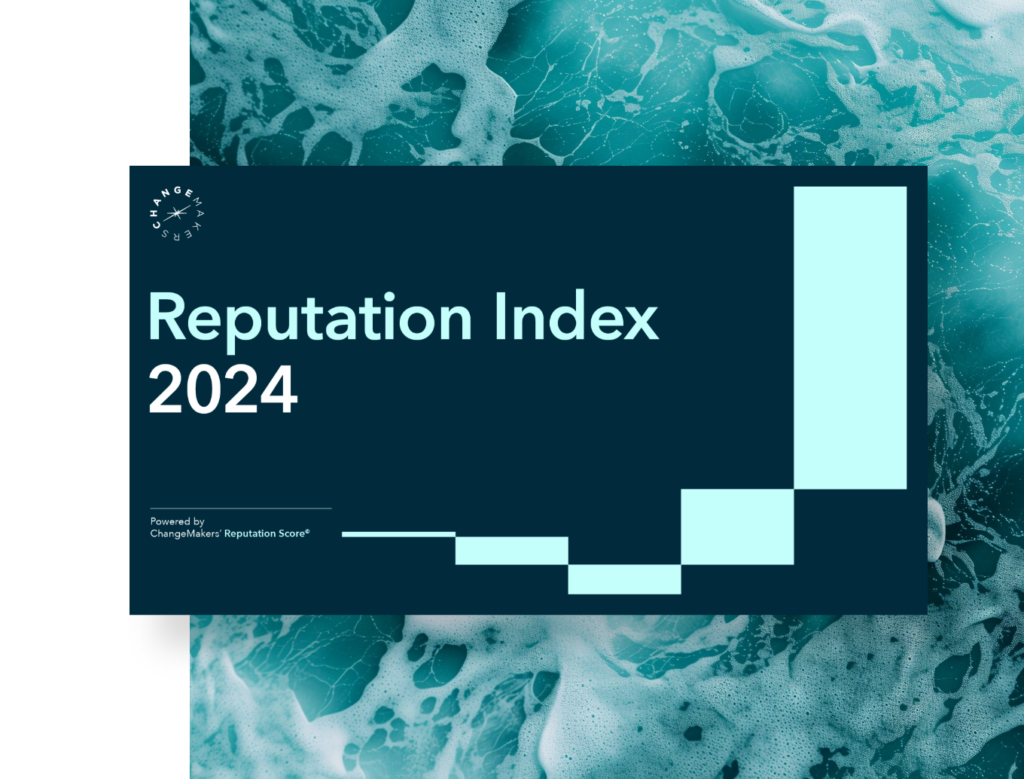
ChangeMakers offices and team members are located across North America within the traditional, Treaty, and unceded territories of First Nations, Inuit, and Métis Peoples.
Our team is currently engaged in the development of a Truth and Reconciliation Action Plan for our company. The Truth and Reconciliation Commission of Canada called upon the corporate sector in Canada to “adopt the United Nations Declaration on the Rights of Indigenous Peoples as a reconciliation framework and to apply its principles, norms, and standards to corporate policy and core operational activities involving Indigenous peoples and their lands and resources” (Call to Action 92).
Our Action Plan is an important measure we are taking as a company and we look forward to updating with more information about this plan and the actions that reflect our commitments as a team.